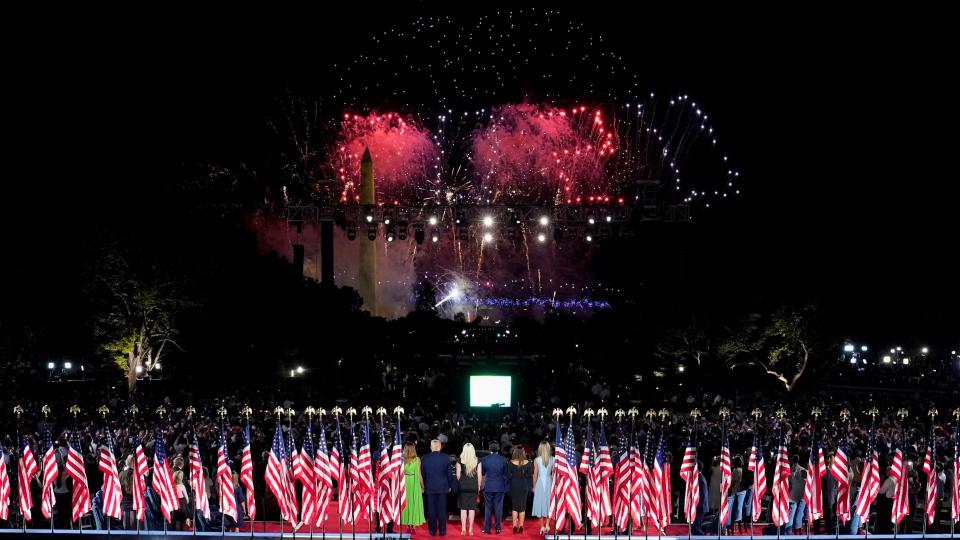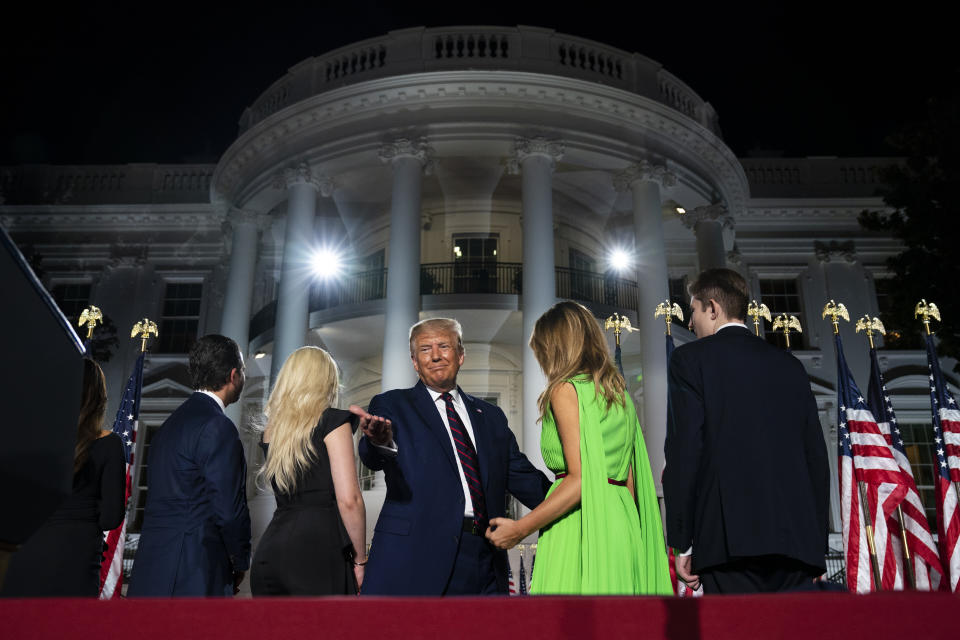The Republican Party’s Full Embrace Of Donald Trump Didn’t Come Out Of Nowhere
President Donald Trump opened the 2020 Republican National Convention by requesting party delegates lead a chant ― not for four more years, but for 12. He spoke on every single night of the convention. Three out of four convention nights featured at least two members of the Trump family as prime-time speakers, making “my dad” and “my father” two of the most uttered phrases. The Republican Party, meanwhile, adopted no platform.
The platform is simply Donald Trump, who embodies all that is good and American. No policies need be explained or, heaven forbid, debated. Trump’s nomination represents them all ― whatever they may be. Any dispute over policy is treated as a personal dispute with the party’s leader and is therefore illegitimate.
The only thing that needs to be expressed is seething resentment and disdain for anyone who dares oppose the beacon of the people. And since the GOP has proven it can win presidential elections without support from a majority of voters, the campaign and convention are all about riling up the base and convincing anyone who’s on the fence to just stay home.

“Always Remember: they are coming after ME, because I am fighting for YOU,” Trump said Thursday night during his unprecedented acceptance speech from the South Lawn of the White House.
This is a stark change from 2016, when Trump led a hostile takeover of the party and speakers like Sen. Ted Cruz (R-Texas) dissented from at the GOP convention in Cleveland. Today, Republicans who may be loyal to the party itself but have not fully bent the knee to Trump are no longer welcome.
“There’s no semblance of a party in any way that is larger than the president,” Daniel Schlozman, a political scientist at Johns Hopkins University and the author of “When Movements Anchor Parties: Electoral Alignments in American History.” “The party is nothing more than support of Trump.”
Trump’s takeover of the Republican Party follows trends stretching back decades. The conservative movement, rooted in cultural, social and racial resentments, took advantage of the hollowing out of political parties that was the side effect of 1970s liberal reforms and poured itself into the GOP to make it what it is today.
“This didn’t come from nowhere,” Schlozman said.
The movement that took over the party and laid the foundation for Trump did so in order to build a durable electoral majority. But that majority no longer exists. Trump’s dominance of the party after his minority-vote victory in 2016 indicates that this conservative coalition increasingly sees its future in power through anti-democratic means.
From Majority To Minority

The New Right conservative movement began as an effort to destroy New Deal liberalism and return to power the ancien régime of Gilded Age economic theories that it wiped away. But it found its true base of support among white voters of all classes who were frightened and angered by the collapse of racial, gender and familial hierarchies. Those fears were hastened by the advances of democratic and social rights for minorities and women and the increase of college education that began in the 1950s.
The conservative movement adopted a pugilistic and win-by-any-means approach to politics with the purpose of “mobilizing cultural and social conflict as a means to majority,” Schlozman and Sam Rosenfeld, a political scientist at Colgate University, write in their 2019 paper, “The Long New Right and the World It Made.”
“The modern Republican Party under the conservative movement’s control represents a continual bargain between a plutocratic public policy agenda and populist social politics,” said Rosenfeld, the author of “The Polarizers: Postwar Architects of Our Partisan Era.”
“Trump is the apotheosis; he’s the reductio ad absurdum; he’s the comical version of that more than he’s a major break,” Rosenfeld said.
While the party pursued plutocratic economic policies, it mollified its voting base by adopting the signature style of Sen. Joseph McCarthy (R-Wis.), mimicking the disgraced anti-Communist’s “fervid demonization, the headlong transgression of institutional and behavioral norms, the suffusion of political debate with potent social resentment,” Schlozman and Rosenfeld write.
That style was on full display at the 2020 GOP convention, where the power and visage of the office of the presidency was used for Trump’s personal private benefit. Meanwhile, convention speakers said the Democratic Party wants to “control how you live,” “invite MS-13 to live next door,” “abolish the suburbs,” and “destroy our way of life” to the point that “you will not recognize this country or yourself.” And, they warned, “no matter where you live, your family will not be safe.”
Although this movement took over the Republican Party, it was never much interested in it as a political party itself. Instead, it saw the party simply as a means to the end of securing an electoral majority ― whether that be Silent or Moral. Building an electoral majority means the party can win. And if it wins, it can enact its agenda.
Toward Minority Rule

The coalition’s marriage of plutocracy and right-wing populism propelled Republicans to smashing success in the second half of the 20th century. The party came to power by pulling on the strings of an unstable New Deal coalition between Southern segregationists, Black Americans, immigrants, labor unions, university intellectuals and rural farmers. That coalition collapsed as the end of Jim Crow, the Vietnam War and economic stagnation mixed with rampant inflation, among other events, pulled apart its internal contradictions. The party went on to win five of six presidential elections from 1968 through 1988.
During this period of dominance, Richard Nixon won 49 states with 61% of the popular vote in his 1972 reelection campaign. Ronald Reagan also won 49 states and 59% in his 1984 reelection campaign. And George H.W. Bush secured 51% in 1988.
Through this period, conservatives stopped and then rolled back progress toward racial equality, stymied the women’s movement by blocking the Equal Rights Amendment and waged a punitive carceral war, with bipartisan support, against the lower classes. But their most durable success was enacting an economic agenda that slashed taxes and ran up massive deficits in order to redistribute money from the poor and the middle class to the rich, and economic power from small to big business.
Nothing was more important to the marriage of the movement and the party than their majority. It was the fact that the party knew it was the majority that kept the populist base in check as the plutocratic wing got what it wanted.
But now that majority has deteriorated. It is, in fact, a minority.
Just look at Trump. He won 46% of the vote in 2016 while losing the popular vote by 3 million votes. He only won the election through the undemocratic mechanism of the Electoral College. That made him the second Republican president to win election in such a way after George W. Bush did so while losing the popular vote in 2000. Before Bush, no president had won the office while losing the popular vote since the 19th century.
Their agenda and message may not pull together a majority coalition, but it is large enough to win minority victories, as long as enough people don’t vote.
Love HuffPost? Become a founding member of HuffPost Plus today.

Trump’s shock minority-vote victory in 2016 ― and his appeasement of the party’s donor class by adopting their plutocratic economic agenda ― set the stage for the unquestioned takeover of the party on display at the GOP convention this week. It has also set in motion the party’s increasing lean toward questioning democracy and liberal government.
When Trump ran in 2016, the most influential intellectual argument for Republicans to fall in line was “The Flight 93 Election,” an openly fascistic screed written by a then-pseudonymous author. The essay likened voting for Trump to the passengers who stormed the cabin and seized control of the flight hijacked by terrorists on 9/11 to save it from being crashed into the U.S. Capitol building. (The plane crashed in Pennsylvania and everyone on board died.)
In this analogy, the Democratic Party and then-nominee Hillary Clinton, are the terrorists. The author — later revealed to be Michael Anton, who went on to serve as a national security aide in the Trump White House — argued that the Democrats were such a threat to the future of the nation that conservatives needed to risk handing an in-flight airplane to Trump, regardless of whether he knew how to fly it. The risk was too simply too high. Why?
“[T]he ceaseless importation of Third World foreigners with no tradition of, taste for, or experience in liberty means that the electorate grows more left, more Democratic, less Republican, less republican, and less traditionally American with every cycle,” Anton wrote.
It always goes back to the pursuit of a majority. It’s the same majority that Kevin Phillips, the political theorist and former Nixon aide who came up with the Republican Party’s Southern Strategy to win racist white voters in the North and South, foresaw in his book ”The Emerging Republican Majority.” It was a majority built on white voters in the South and North repelled by the advances in democracy and freedom for Black Americans. A majority that is now a minority in a nation where white people will make up less than 50% of the population in 25 years.
This explains Charlie Kirk — a Republican youth leader whose organization, Turning Point USA, has repeatedly been found to employ white supremacists — calling Trump “the bodyguard of Western civilization” at the convention.
Trump’s coronation tilts the party ever further toward the anti-democratic instincts that have always run just beneath the surface. This week, the party nodded in support of Trump’s illiberalism and bet their hopes on another victory through anti-democratic constitutional mechanisms to continue their rule ― majority be damned.
“He has revealed and kicked the tires around to show what it is that [the party’s] elite economic interests and ordinary voters will accept to keep the coalition going,” Rosenfeld said.
Trump’s vision of permanent minority rule, it seems, is the only hope to secure the existence of, and a future for, the ruling conservative coalition.
Related...
White Nationalism Is Stalking The Republican National Convention
4,000 People Died From COVID-19 While The RNC Pretended The Pandemic Is Over
RNC Speakers: Sure, Trump Can Be A Jerk. But He's Not That Bad. Really.
The Race For 2024 Was On Full Display At The RNC
This article originally appeared on HuffPost and has been updated.

